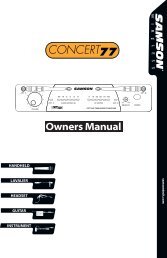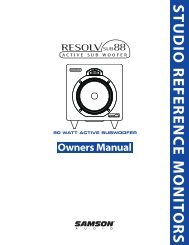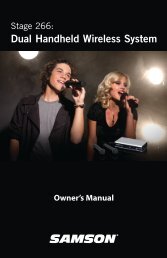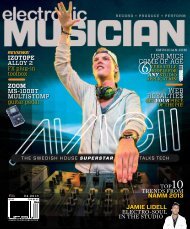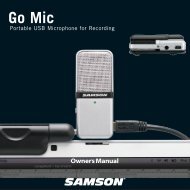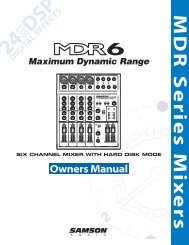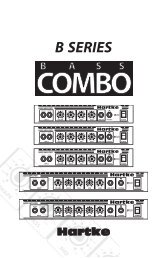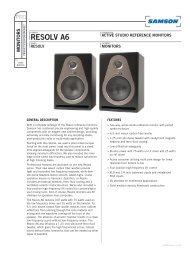Samson Q3 Microphone User Manual in PDF format
Samson Q3 Microphone User Manual in PDF format
Samson Q3 Microphone User Manual in PDF format
Create successful ePaper yourself
Turn your PDF publications into a flip-book with our unique Google optimized e-Paper software.
VOCAL / INSTRUMENT<br />
AND INSTRUMENT<br />
Q2 VOCAL / INSTRUMENT MIC<br />
OWNERS MANUAL<br />
<strong>Q3</strong> INSTRUMENT MIC<br />
®
Table of Contents<br />
Introduction 3<br />
Q2 / <strong>Q3</strong> Features 4<br />
Us<strong>in</strong>g Your Q2 / <strong>Q3</strong> <strong>Microphone</strong> 5<br />
Other <strong>Samson</strong> <strong>Microphone</strong>s 8<br />
Specifications 9<br />
Produced by On The Right Wavelength for <strong>Samson</strong> Technologies Corp.<br />
Copyright 1997, <strong>Samson</strong> Technologies Corp.<br />
Pr<strong>in</strong>ted June, 1997<br />
<strong>Samson</strong> Technologies Corp.<br />
575 Underhill Blvd.<br />
P.O. Box 9031<br />
Syosset, NY 11791-9031<br />
Phone: 1-800-3-SAMSON (1-800-372-6766)<br />
Fax: 516-364-3888
Introduction<br />
Congratulations on purchas<strong>in</strong>g the <strong>Samson</strong> Q2 or <strong>Q3</strong> <strong>Microphone</strong>!<br />
These radically new professional dynamic mics are specially designed<br />
for use <strong>in</strong> live performance. The compact Q2 is equally effective as a<br />
vocal or <strong>in</strong>strument mic, while the <strong>Q3</strong> is optimized for drum mik<strong>in</strong>g<br />
applications. Both models are manufactured with extreme care and the<br />
highest quality components, deliver<strong>in</strong>g an exceptionally clear, articulate<br />
sound. Their transformless design provides extended low frequency<br />
response while m<strong>in</strong>imiz<strong>in</strong>g low frequency distortion. Both also <strong>in</strong>clude a<br />
dist<strong>in</strong>ctive multi-stage w<strong>in</strong>dscreen and filter for effectively reduc<strong>in</strong>g pops,<br />
sibilance and on-stage noise, and a unique humbuck<strong>in</strong>g voice coil to<br />
elim<strong>in</strong>ate outside <strong>in</strong>terference. The cardioid pattern utilized by the Q2<br />
and the hypercardioid pattern utilized by the <strong>Q3</strong> provides important<br />
feedback rejection while deliver<strong>in</strong>g a strong, crisp signal from the audio<br />
source directly <strong>in</strong> front of the mic capsule. The Q2 and <strong>Q3</strong> microphones<br />
are also particularly well-suited for use with <strong>Samson</strong> wireless systems.<br />
In this manual, you’ll f<strong>in</strong>d a more detailed description of the features of<br />
your Q2 / <strong>Q3</strong> microphone, as well as <strong>in</strong>structions for its use (<strong>in</strong>clud<strong>in</strong>g<br />
wir<strong>in</strong>g diagrams) and complete specifications. You’ll also f<strong>in</strong>d a warranty<br />
card enclosed—don’t forget to fill it out and mail it <strong>in</strong>! This will enable<br />
you to receive onl<strong>in</strong>e technical support and will allow us to send you<br />
updated <strong>in</strong><strong>format</strong>ion about other <strong>Samson</strong> products <strong>in</strong> the future.<br />
SPECIAL NOTE: Should your Q2 or <strong>Q3</strong> microphone ever require<br />
servic<strong>in</strong>g, a Return Authorization number (RA) is necessary. Without<br />
this number, the microphone will not be accepted. Please call <strong>Samson</strong><br />
at (516) 364-2244 for a Return Authorization number prior to shipp<strong>in</strong>g<br />
your microphone. Please reta<strong>in</strong> the orig<strong>in</strong>al pack<strong>in</strong>g material and, if<br />
possible, return the microphone <strong>in</strong> its orig<strong>in</strong>al carton and pack<strong>in</strong>g<br />
materials.<br />
3
Q2 / <strong>Q3</strong> Features<br />
The <strong>Samson</strong> Q2 and <strong>Q3</strong> microphones utilize state-of-the-art<br />
microphone technology and are eng<strong>in</strong>eered to the f<strong>in</strong>est detail.<br />
Here are some of their ma<strong>in</strong> features:<br />
• High energy rare earth Neodymium element delivers high output<br />
and exceptional sound quality.<br />
• Transformerless design enables extended low frequencies and<br />
reduces low frequency distortion.<br />
• Tight polar patterns m<strong>in</strong>imize feedback problems and effectively<br />
reject signals not orig<strong>in</strong>at<strong>in</strong>g directly <strong>in</strong> front of the mic capsule.<br />
• Full range frequency response for optimum reproduction of vocals<br />
and <strong>in</strong>struments with an exceptionally clear, crisp sound.<br />
• Vertical port<strong>in</strong>g that works to remove stand<strong>in</strong>g wave distortion.<br />
• Extremely lightweight alum<strong>in</strong>um humbuck<strong>in</strong>g voice coil elim<strong>in</strong>ates<br />
magnetic field <strong>in</strong>terference and provides true hum rejection right at<br />
the source while deliver<strong>in</strong>g extended high frequencies.<br />
• Unique triple-plated multi-stage w<strong>in</strong>dscreen enables “up-close”<br />
usage and greatly reduces pops, sibilance and onstage noise.<br />
• Special shock-mount<strong>in</strong>g allows multi-axis movement of the mic<br />
element <strong>in</strong> order to greatly reduce handl<strong>in</strong>g noise.<br />
• Rugged z<strong>in</strong>c-cast<strong>in</strong>g, silicon anti-dent r<strong>in</strong>g and gold-plated<br />
XLR connector ensures reliable performance <strong>in</strong> even the most<br />
demand<strong>in</strong>g environments.<br />
• Switchable 10 dB pad enables use with high sound pressure level<br />
(SPL) signal sources such as drums or amplified <strong>in</strong>struments.<br />
• Switchable 12 dB / octave high pass filter (HPF) tuned to 80 Hz for<br />
elim<strong>in</strong>at<strong>in</strong>g rumble.<br />
• Lightweight and compact, the Q2 can be mounted on any standard<br />
microphone stand (us<strong>in</strong>g the <strong>in</strong>cluded mic clip) or can be easily<br />
handheld for long periods without <strong>in</strong>duc<strong>in</strong>g fatigue. Equally<br />
compact, the <strong>Q3</strong> mounts directly on a mic stand (no clip required)<br />
and rotates mechanically 90° for optimum placement—particularly<br />
handy when mik<strong>in</strong>g large drum kits on small stages!<br />
• Included foam-l<strong>in</strong>ed carry<strong>in</strong>g case and Euro metric mic stand<br />
adapter.<br />
4
Us<strong>in</strong>g Your Q2 / <strong>Q3</strong> <strong>Microphone</strong><br />
The Q2 / <strong>Q3</strong> can be connected to any audio system us<strong>in</strong>g a standard<br />
microphone cable. As shown <strong>in</strong> the wir<strong>in</strong>g diagrams below, connect the<br />
female XLR end directly to the Q2 or <strong>Q3</strong>’s gold-plated connector and the<br />
other end (normally a male XLR, although some mixers use 1/4"<br />
connectors) to your mixer, mixer/amplifier, or mic preamp.<br />
XLR to XLR<br />
cable<br />
XLR to 1/4" TRS<br />
cable (balanced)<br />
XLR to 1/4" TS<br />
cable (unbalanced)<br />
F<br />
1 2<br />
F<br />
3<br />
1 2<br />
3<br />
F<br />
1 2<br />
3<br />
Sleeve<br />
M<br />
2 1<br />
3<br />
R<strong>in</strong>g R<strong>in</strong>g (cold)<br />
Sleeve (ground) Tip (hot)<br />
Tip<br />
The Q2 can be mounted to any standard microphone stand (us<strong>in</strong>g the<br />
<strong>in</strong>cluded mic clip) or can be handheld; due to its unique multi-axis mic<br />
element shock mount<strong>in</strong>g, it generates significantly less handl<strong>in</strong>g noise<br />
than most other microphones. If handheld, take care not to cover the<br />
head grille with your hand. The <strong>Q3</strong> provides its own mount<strong>in</strong>g that can<br />
be rotated through 90° for easy placement <strong>in</strong> tight spaces such as<br />
around drum kits. When connect<strong>in</strong>g either model to a European (metric)<br />
microphone stand, use the provided “Euro” adapter.<br />
When position<strong>in</strong>g any microphone, be aware of a phenomenon called<br />
the proximity effect which causes a noticeable <strong>in</strong>crease <strong>in</strong> low<br />
frequencies (bass response) when a microphone is close to the audio<br />
source. This can have positive impact—for example, it will cause your<br />
voice to sound much fuller when you s<strong>in</strong>g close to the mic than when you<br />
s<strong>in</strong>g at a distance. Both the Q2 and the <strong>Q3</strong> are specially designed to be<br />
used up close, s<strong>in</strong>ce they provide a w<strong>in</strong>dscreen with built-<strong>in</strong> sibilance<br />
filter (as shown <strong>in</strong> the illustration on the follow<strong>in</strong>g page) for removal of<br />
pops, sibilance and onstage noise. The key to develop<strong>in</strong>g the best mic<br />
technique is experimentation, along with awareness of the general<br />
pr<strong>in</strong>ciple that, the closer a microphone is to a signal source, the greater<br />
the bass response.<br />
5
Us<strong>in</strong>g Your Q2 / <strong>Q3</strong> <strong>Microphone</strong><br />
W<strong>in</strong>dscreen<br />
Sibilance filter<br />
Every microphone has a characteristic polar pattern that determ<strong>in</strong>es<br />
how well it accepts or rejects signal com<strong>in</strong>g from various areas around<br />
the microphone. For example, omnidirectional mics accept all signals<br />
regardless of wherever those signals orig<strong>in</strong>ate (<strong>in</strong> front of the mic,<br />
beh<strong>in</strong>d it, to the side, etc.). In contrast, directional cardioid mics such as<br />
the Q2 are specifically designed to accept mostly signal com<strong>in</strong>g from<br />
directly <strong>in</strong> front, and to reject signal com<strong>in</strong>g from beh<strong>in</strong>d or from the<br />
side. The most extreme variation of cardioid is the hypercardioid<br />
pattern utilized by the <strong>Q3</strong>; this yields maximum rejection of signal<br />
com<strong>in</strong>g from any direction other than directly <strong>in</strong> front of the mic.<br />
The illustrations below show the polar patterns for the Q2 and <strong>Q3</strong>.<br />
330°<br />
0°<br />
30°<br />
330°<br />
0°<br />
30°<br />
300°<br />
60°<br />
300°<br />
60°<br />
270°<br />
90°<br />
270°<br />
90°<br />
240°<br />
120°<br />
240°<br />
120°<br />
210°<br />
180°<br />
150°<br />
210°<br />
180°<br />
150°<br />
300Hz<br />
1000Hz<br />
3000Hz<br />
Scale is 5 decibels per division<br />
300Hz<br />
1000Hz<br />
3000Hz<br />
Scale is 5 decibels per division<br />
Q2 Polar Pattern<br />
<strong>Q3</strong> Polar Pattern<br />
6
M IC<br />
Us<strong>in</strong>g Your Q2 / <strong>Q3</strong> <strong>Microphone</strong><br />
As you can see from these illustrations, both the Q2 and <strong>Q3</strong> excel <strong>in</strong><br />
environments where there is significant unwanted ambient sound s<strong>in</strong>ce<br />
they deliver those signals orig<strong>in</strong>at<strong>in</strong>g directly <strong>in</strong> front of the mic capsule<br />
itself while reject<strong>in</strong>g those that orig<strong>in</strong>ate from beh<strong>in</strong>d.<br />
The polar pattern also determ<strong>in</strong>es how prone a particular mic is to<br />
<strong>in</strong>duc<strong>in</strong>g feedback. Feedback is that characteristic nasty howl<strong>in</strong>g sound<br />
that occurs when a mic is placed too close to a loudspeaker—the signal<br />
from the loudspeaker is fed <strong>in</strong>to the mic, then <strong>in</strong>to the loudspeaker, then<br />
<strong>in</strong>to the mic, over and over aga<strong>in</strong> until an oscillat<strong>in</strong>g tone is generated.<br />
Because the polar patterns utilized by the Q2 / <strong>Q3</strong> are so good at<br />
reject<strong>in</strong>g signal not com<strong>in</strong>g from directly <strong>in</strong> front of the mic, you’ll f<strong>in</strong>d that<br />
their use greatly m<strong>in</strong>imizes feedback problems.<br />
As shown <strong>in</strong> the illustrations below, the Q2 and <strong>Q3</strong> mics also provide<br />
switches that allow you to engage a 10 dB pad or a high pass filter<br />
(HPF). For normal use, leave both switches <strong>in</strong> their “off” position.<br />
Place the 10 dB pad switch <strong>in</strong> its “on” position when mik<strong>in</strong>g a signal<br />
(such as drums or <strong>in</strong>strument amplifiers) that has a high sound pressure<br />
level (SPL) or whenever you hear overload distortion at your mixer or<br />
mic preamp <strong>in</strong>put. Place the HPF switch <strong>in</strong> its “on” position to filter out<br />
low frequency rumble (such as might be caused by onstage floor noise).<br />
The Q2 / <strong>Q3</strong> HPF is tuned to 80 Hz, with a rolloff of 12 dB per octave.<br />
SAMSON Q 2<br />
HP<br />
ON<br />
ATT<br />
HP ATT<br />
ON<br />
7
Other <strong>Samson</strong> <strong>Microphone</strong>s<br />
<strong>Samson</strong> Technologies is the manufacturer of a broad range of<br />
microphones, each optimized for a different application, but with each<br />
shar<strong>in</strong>g the same f<strong>in</strong>e quality of your Q2 or <strong>Q3</strong>.<br />
Q MIC<br />
The Q MIC is a neodymium hypercardioid mic designed for high-end<br />
vocal applications where there is significant background or<br />
environmental noise. It shares many of the same features as the Q2,<br />
but utilizes a midrange “presence” peak at 2 kHz for optimum<br />
reproduction of vocals. Other features <strong>in</strong>clude special shock-mount<strong>in</strong>g<br />
that allows 360° X-Y axis movement of the mic element <strong>in</strong> order to<br />
greatly reduce handl<strong>in</strong>g noise and a neoprene transformer cover <strong>in</strong><br />
order to m<strong>in</strong>imize microphonic self-noise.<br />
QV / QE<br />
These are two professional lavalier (clip-on) microphones specially<br />
designed for perform<strong>in</strong>g musicians and dancers, sportscasters and<br />
aerobics <strong>in</strong>structors. The QE model is waterproof and is optimized for<br />
aerobics use and high-humidity environments. Both are lightweight and<br />
utilize a low visibility design for unobtrusive use, with high quality<br />
electret condenser elements for high output and exceptional sound<br />
quality. The QV model has a hypercardioid polar pattern and virtually<br />
flat frequency response to 10 kHz, while the QE utilizes a bi-directional<br />
noise cancellation circuit and a midrange “presence” peak for optimum<br />
reproduction of speech.<br />
S12 / S11<br />
These are two affordable yet high quality dynamic microphones for the<br />
musician on a budget. Both are lightweight and compact, yet have<br />
rugged capsules that enable them to be used with high sound pressure<br />
level signals (such as drums and amplified <strong>in</strong>struments) with reliable<br />
performance <strong>in</strong> even the most demand<strong>in</strong>g environments. The S11<br />
model utilizes a standard cardioid polar pattern while the S12 utilizes a<br />
hypercardioid polar pattern for maximum feedback rejection and<br />
<strong>in</strong>cludes a rare earth neodymium magnet that provides 6 dB of<br />
noiseless ga<strong>in</strong>.<br />
8
Specifications<br />
Type<br />
Polar Pattern<br />
Q2<br />
<strong>Q3</strong><br />
Frequency Response<br />
Sensitivity<br />
Impedance<br />
HP Range<br />
Att Range<br />
Connector<br />
Dimensions<br />
Q2 (length)<br />
<strong>Q3</strong> (length, head)<br />
<strong>Q3</strong> (length, mount<strong>in</strong>g)<br />
Weight<br />
Q2<br />
<strong>Q3</strong><br />
Dynamic<br />
Cardioid<br />
Hyper-cardioid<br />
50 Hz - 15 kHz<br />
-71 dB ± 3 dB<br />
(0 dB = 1V/0.1pa @ 1 kHz)<br />
600 ohm (@ 1 kHz)<br />
-12 dB / octave (HP switch ON)<br />
-10 dB / average (ATT switch ON)<br />
3-p<strong>in</strong> gold-plated balanced XLR male<br />
6 <strong>in</strong>. / 152 mm<br />
4 <strong>in</strong>. / 102 mm<br />
3 <strong>in</strong>. / 76 mm<br />
10.5 oz. / 300 g<br />
15.1 oz. / 431 g<br />
9



